Japanese ARTH Exam II
1/27
There's no tags or description
Looks like no tags are added yet.
Name | Mastery | Learn | Test | Matching | Spaced |
|---|
No study sessions yet.
28 Terms
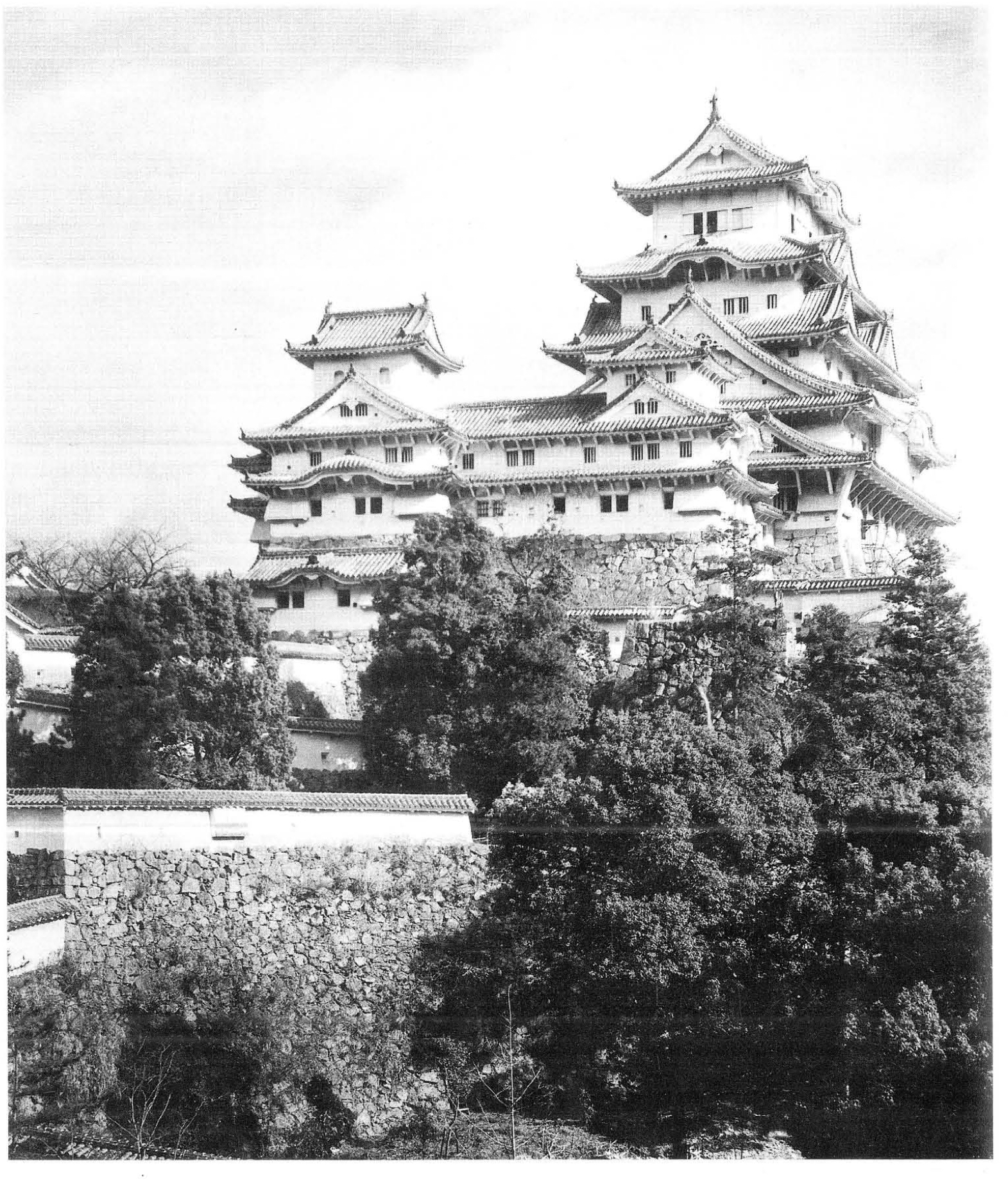
Himeji Castle (273)
1601-09, AKA White Heron Castle
A show of power, greatly contrasts tea houses and contains mazes, rock chutes, and more deterrents
Tanshukaku - Multi-level building style often used in castle architecture, showing power and prestige.
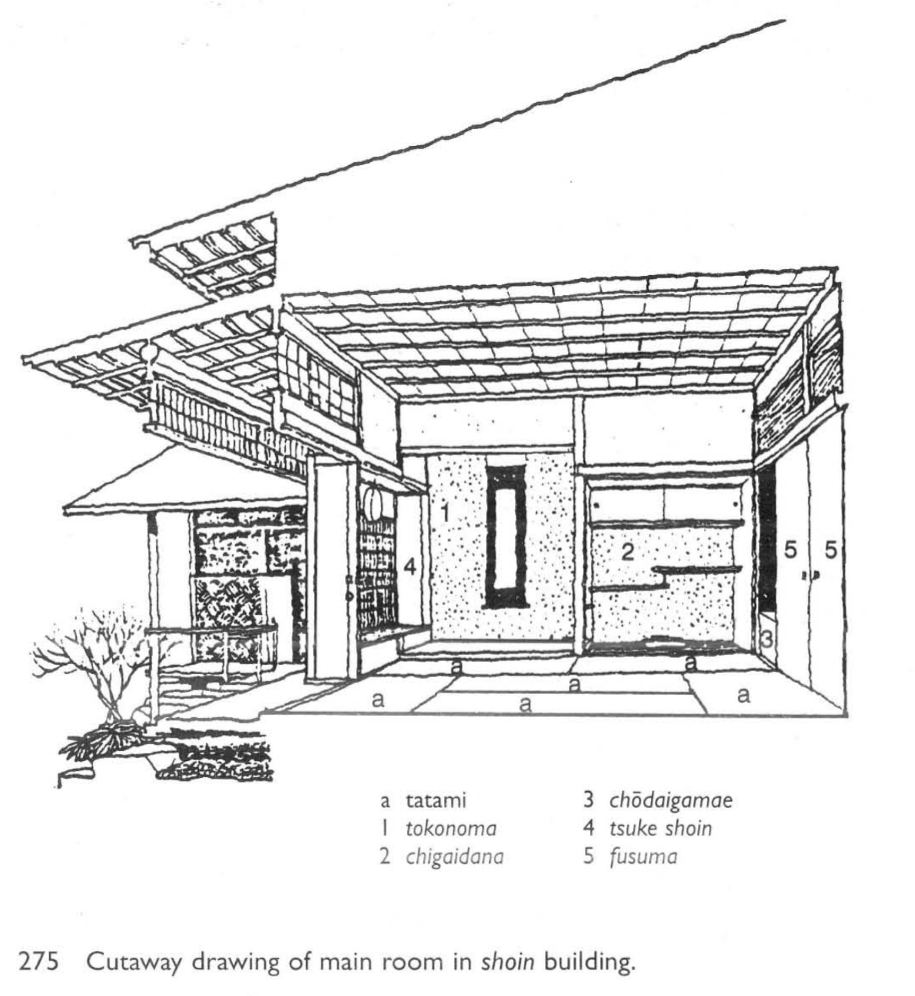
Shoin (275)
A traditional Japanese architectural style that includes elements such as tatami mats and sliding doors, typically used in tea houses and schools.
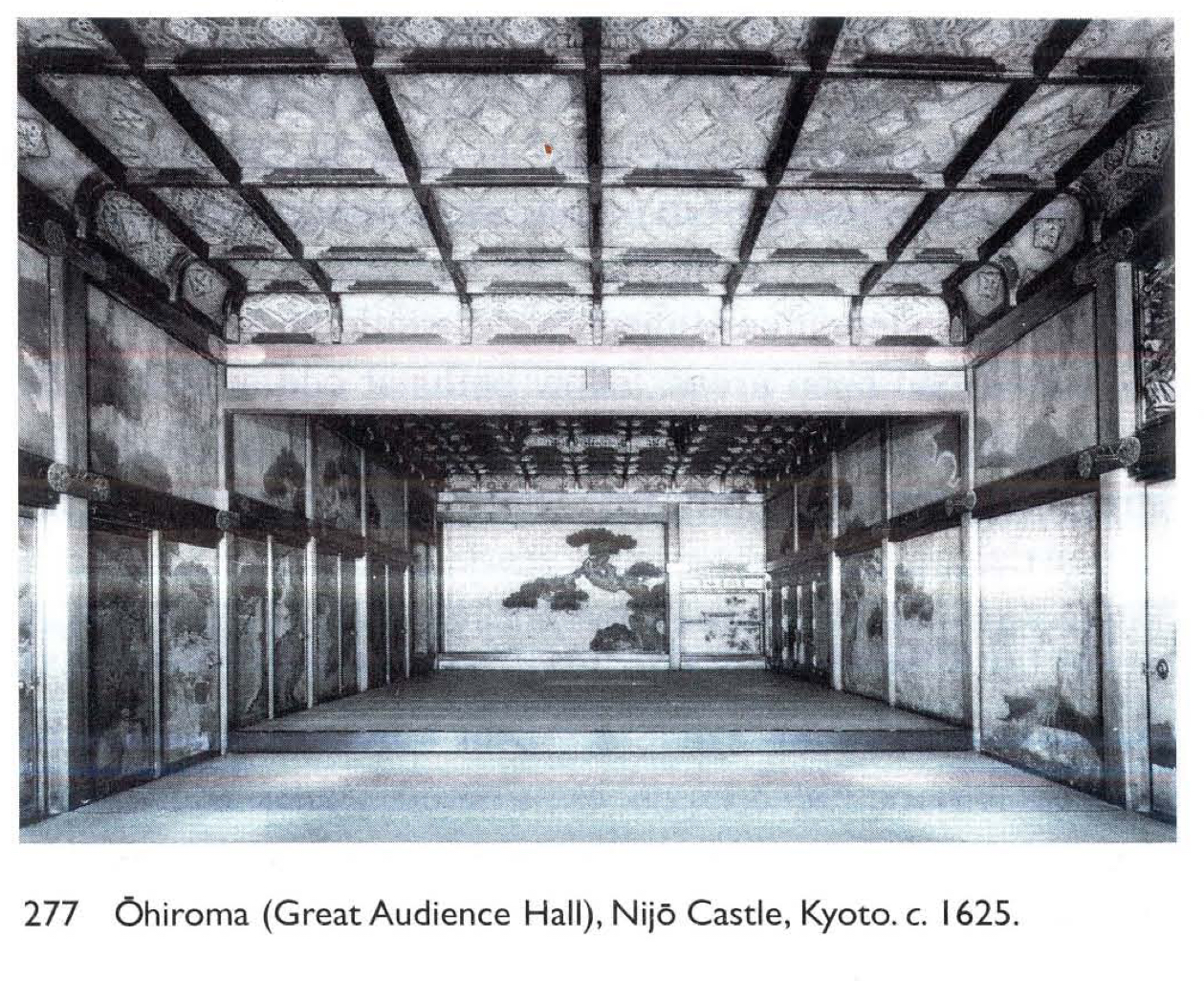
Ohiroma (Great Audience Hall) Nijo Castle (277)
1625
Tiered room to showcase the power of the Shogun with elaborate decorations and a spacious layout for hosting important guests
Pine tree on gold background would light room and serve as metaphor for strength and enduring nature of his bakufu (military power)
Fusuma - Sliding doors used in traditional interiors; major sites for painting and seasonal change.
Shoin style
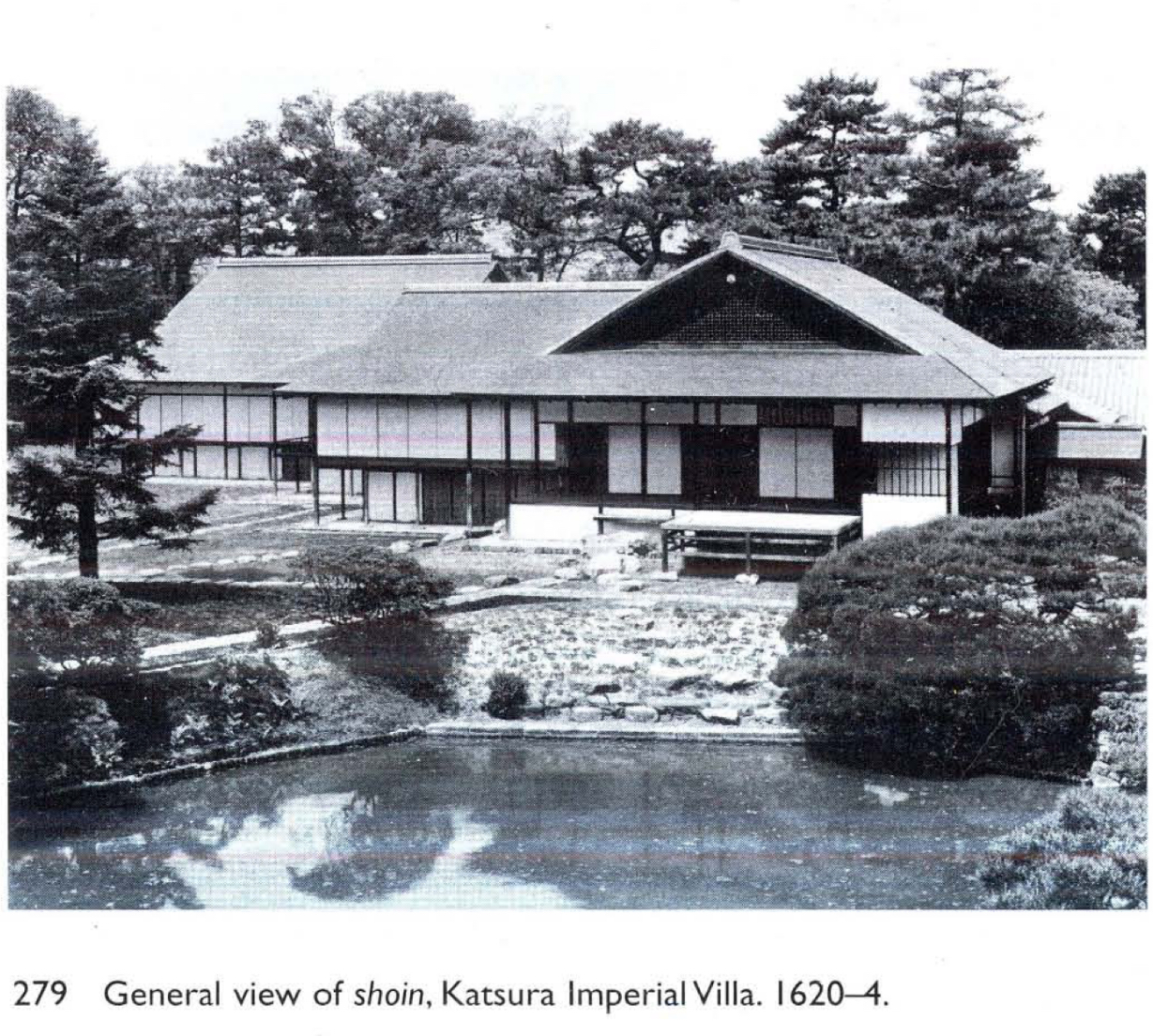
Katsura Imperial Villa (279)
1620-24
Shows harmony with nature and incorporates various styles of Japanese architecture like shoin, showcasing a perfect balance between design and natural surroundings.
Nod to the tale of Genji
Emphasis on the moon and wabi-sabi
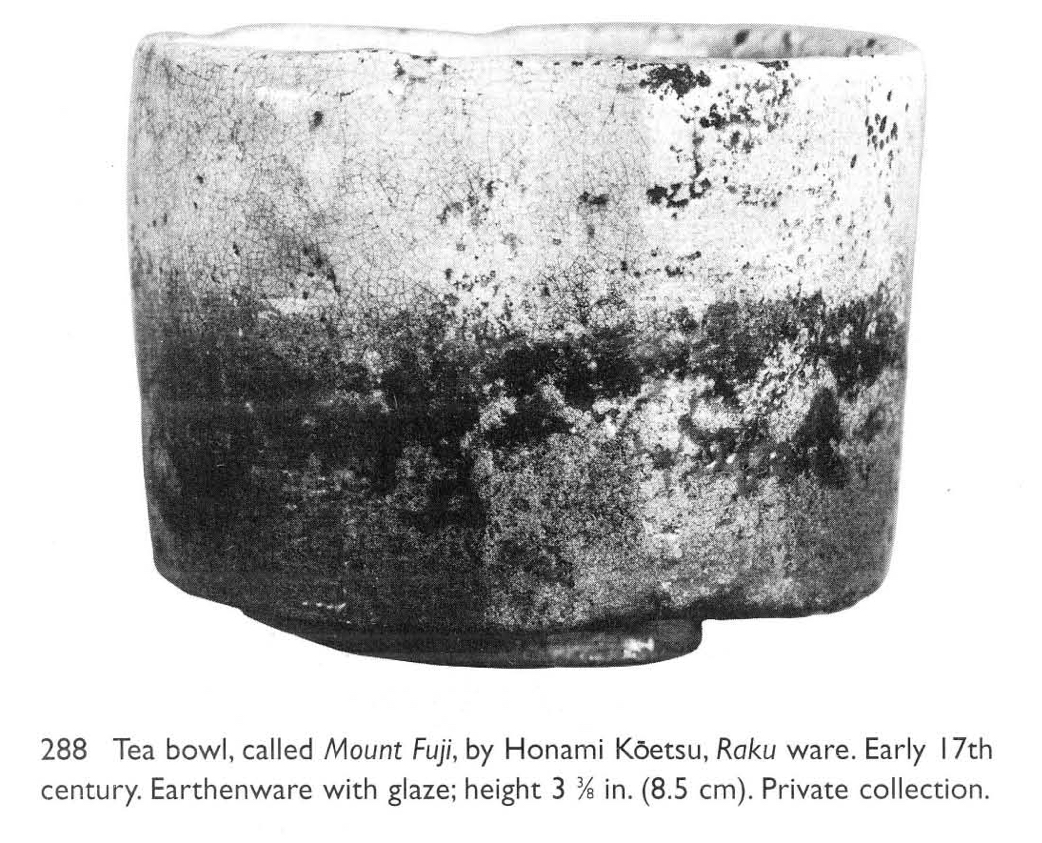
Tea bowl, Mount Fuji (288)
Honami Koetsu, early 1600s
fuji means unparalleled, which captures this tea bowl
koetsu was a tea master as well as an artist and is known for his exquisite craftsmanship in ceramics, particularly in the style of tea ware
earthen ware with glaze
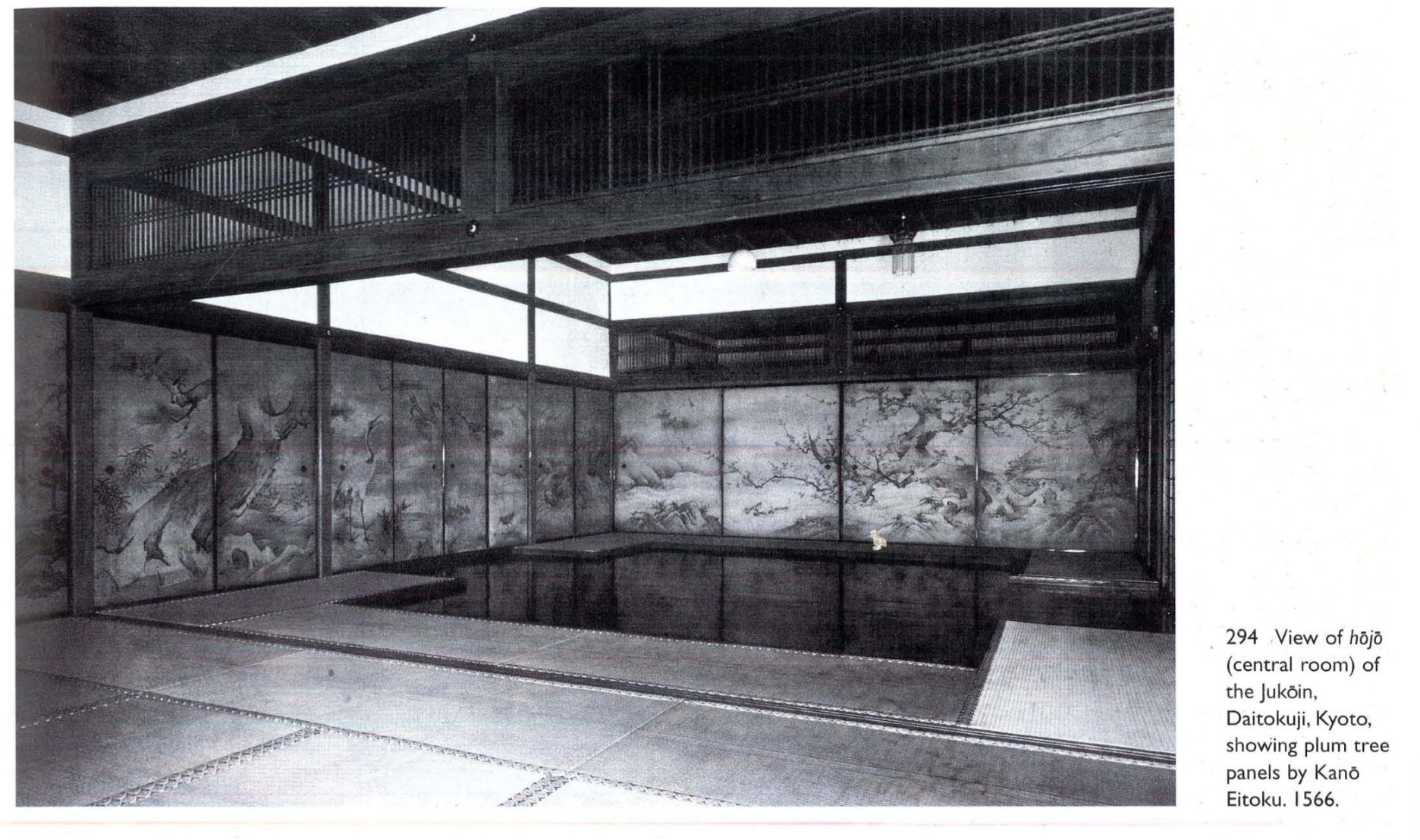
Hojo of the Jukoin, Daitokuji (Plum tree panels) (294)
1566
Kano Eitoku (Kano School)
striking plum tree fusuma that enhance the spiritual ambiance of Zen spaces, demonstrating masterful ink painting techniques
Pale gold mists
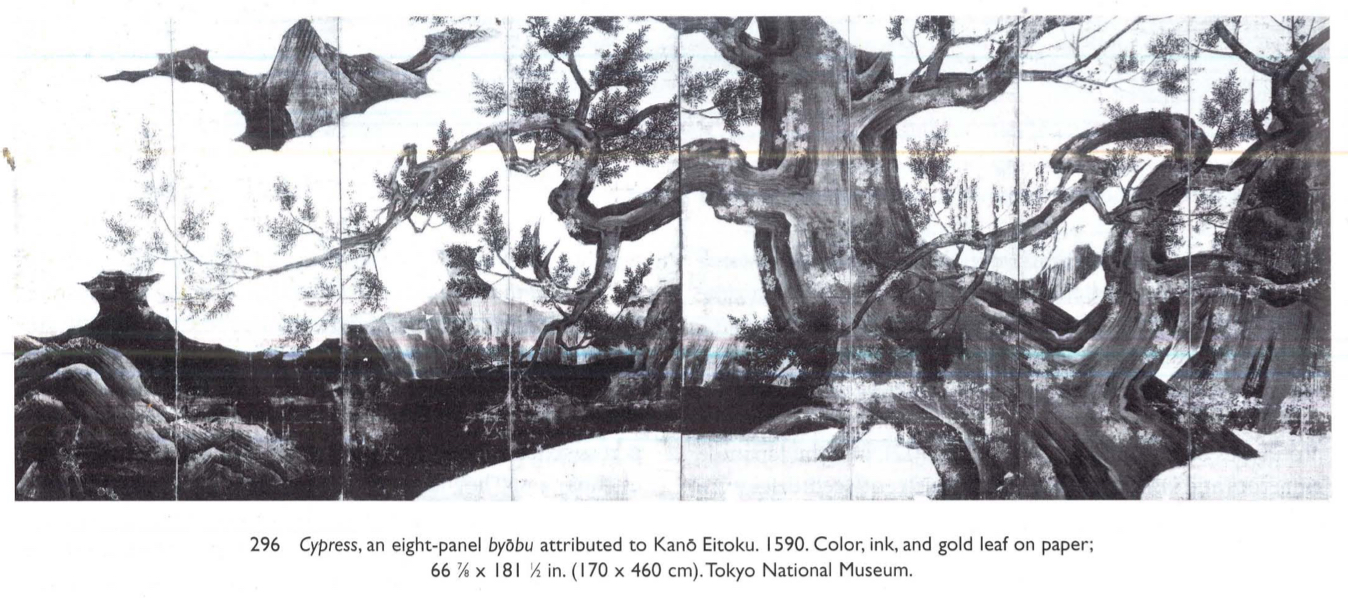
Cypress Byobu (296)
1590
Kano Eitoku
byobu that features vibrant cypress tree imagery, showcasing the painter's skill in conveying natural beauty and deep symbolism in traditional Japanese art
Byobu, color, ink, and gold leaf on paper

Maple Tree on 4 Futsuma (301)
Late 16th Century, Momoyama Period
Hasegawa Tohaku
Influenced by Kano school
Kanga style -
Color and gold leaf on paper
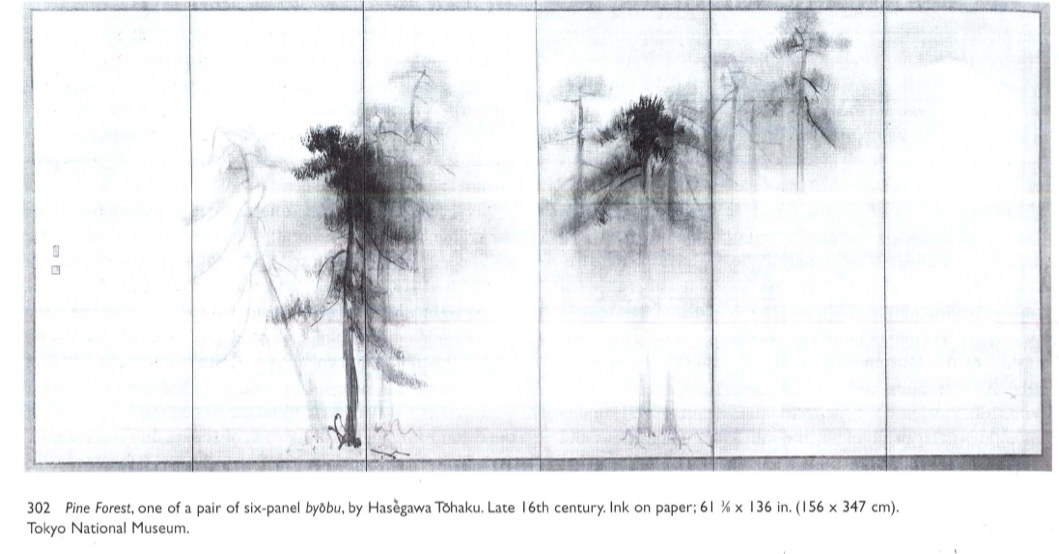
Pine Forest Byobu (302)
Late 16th Century
Hasegawa Tohaku
This was made after the death of his son
Ink on paper

Matsuishima screens (311)
17th Century
Sotatsu
Sankei - 3 most beautiful views of Japan
Ink, color, and gold leaf on paper
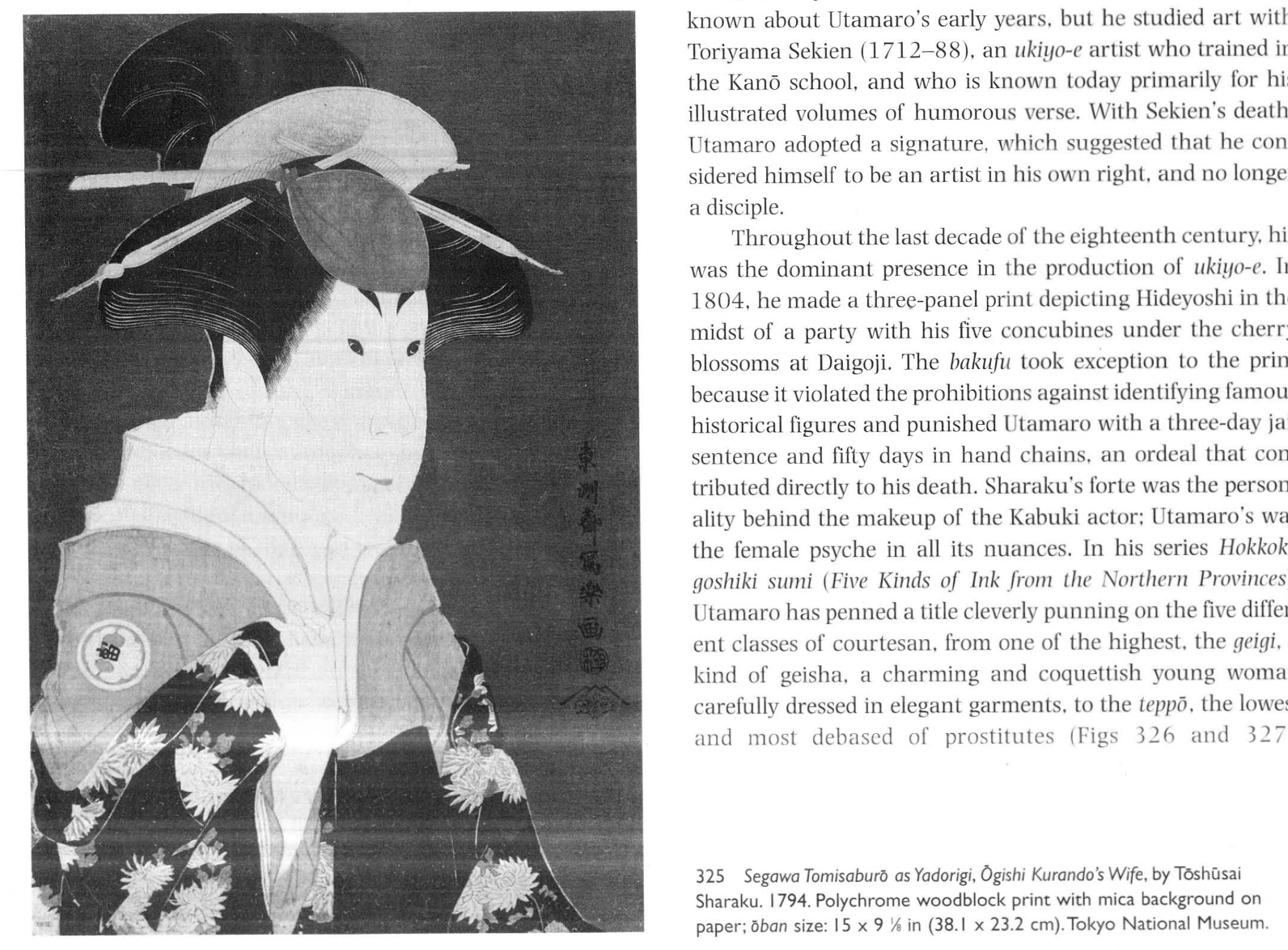
Segawa Tomisaburo as Yadorigi (325)
1794
Toshusai Sharaku
This print features Segawa Tomisaburo, a famous kabuki actor, depicted in a dramatic pose that showcases Sharaku's unique style and mastery of portraiture.
Ukiyo-e – “Pictures of the floating world,” woodblock prints of urban life, courtesans, kabuki actors.
Woodblock print with mica background on paper
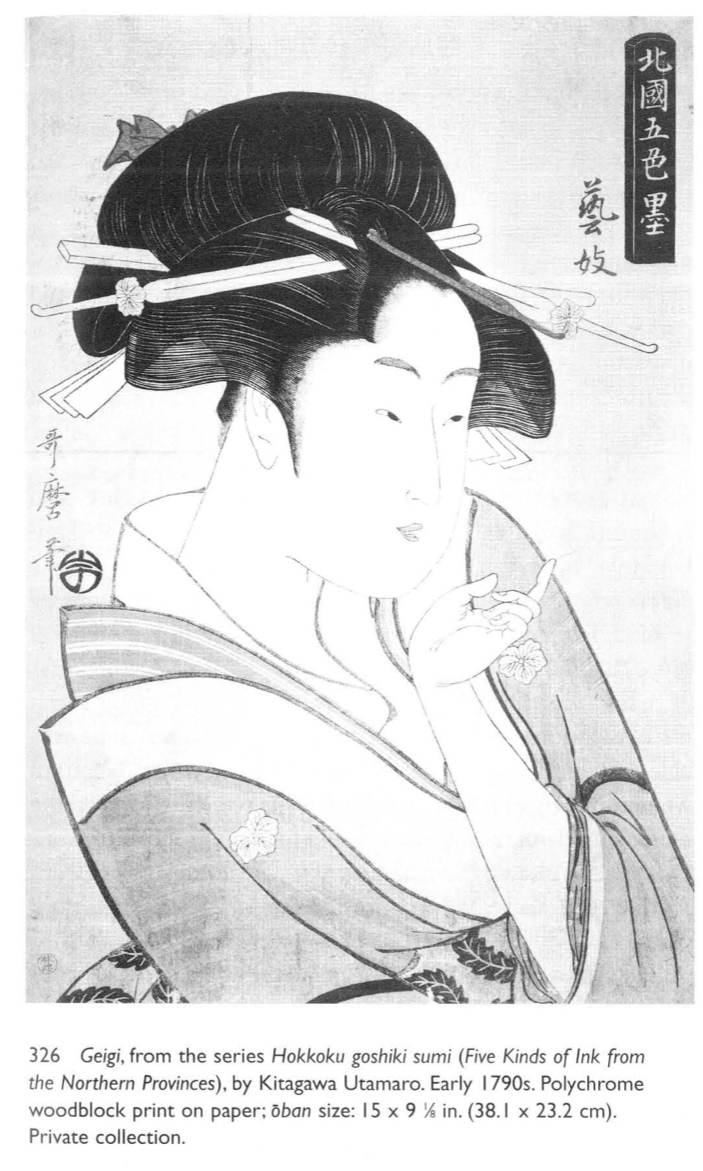
Geigi from the series Five Kinds of Ink from the Northern Provinces (326)
Early 1790s
Kitagawa Utamaro
This print features Geigi, showcasing Utamaro's refined technique and attention to detail in capturing the beauty and grace of traditional Japanese courtesans.
Bijinga: The depiction of the geigi in this print is an example of bijinga, a specific ukiyo-e genre that portrays beautiful women, capturing elegance and the aesthetics of feminine beauty in the Edo period.
Polychrome woodblock print on paper
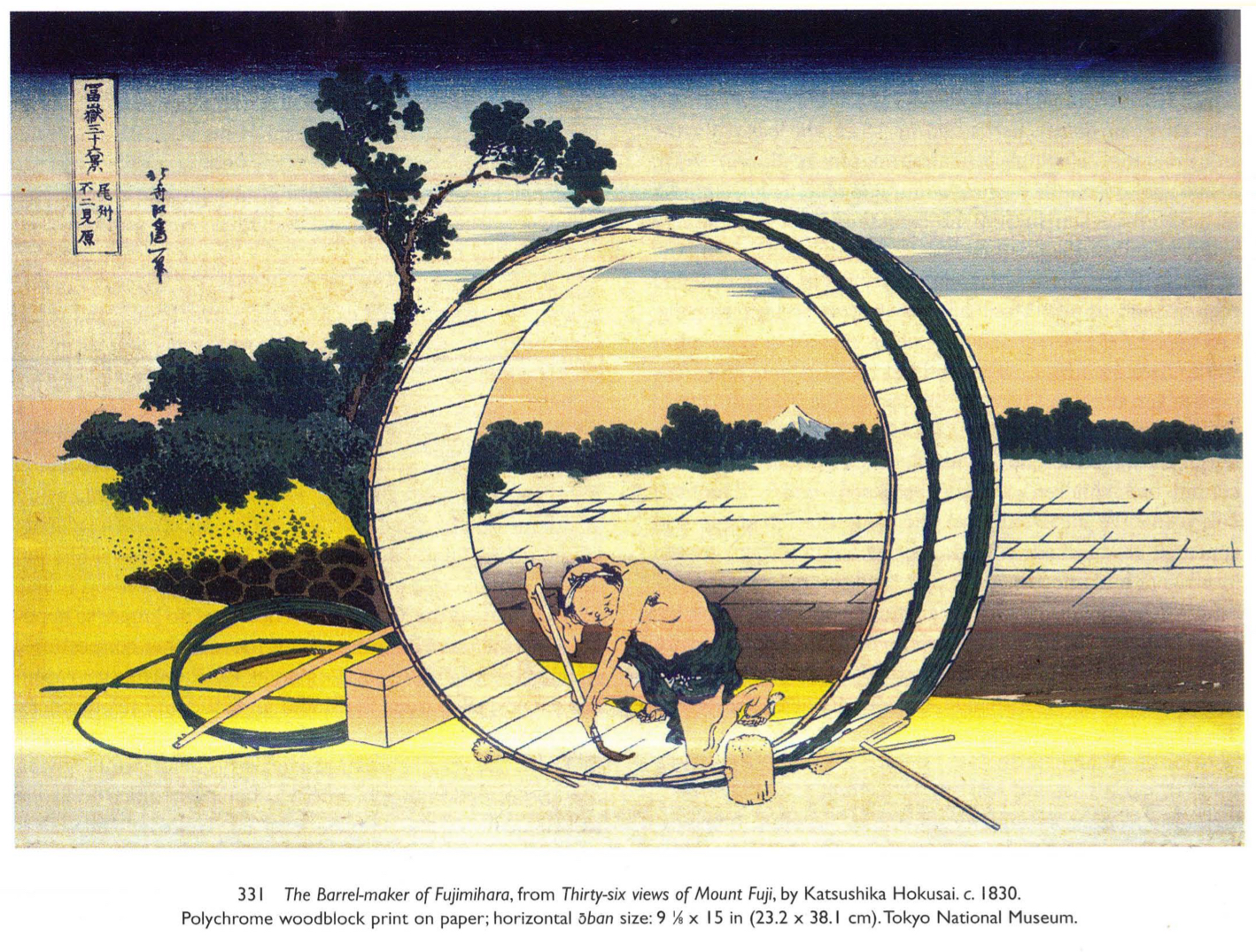
The Barrel-Maker of Fujimihara, 36 Views of Mount Fuji (331)
1830
Katsushika Hokusai
This print depicts the barrel-maker at work, highlighting Hokusai's ability to blend everyday life with the majestic presence of Mount Fuji in the background. It showcases his detailed compositions and vibrant use of color.
Ukiyo-e: This series, including "The Barrel-Maker of Fujimihara," is a prime example of ukiyo-e, depicting scenes of everyday life and landscapes, with Mount Fuji as a central theme.
Nishiki-e: The prints from the 36 Views of Mount Fuji series are nishiki-e, using multiple woodblocks to produce vibrant, full-color prints with intricate details.
Oban – Standard print size for ukiyo-e (about 15" x 10").
Polychrome woodblock print on paper
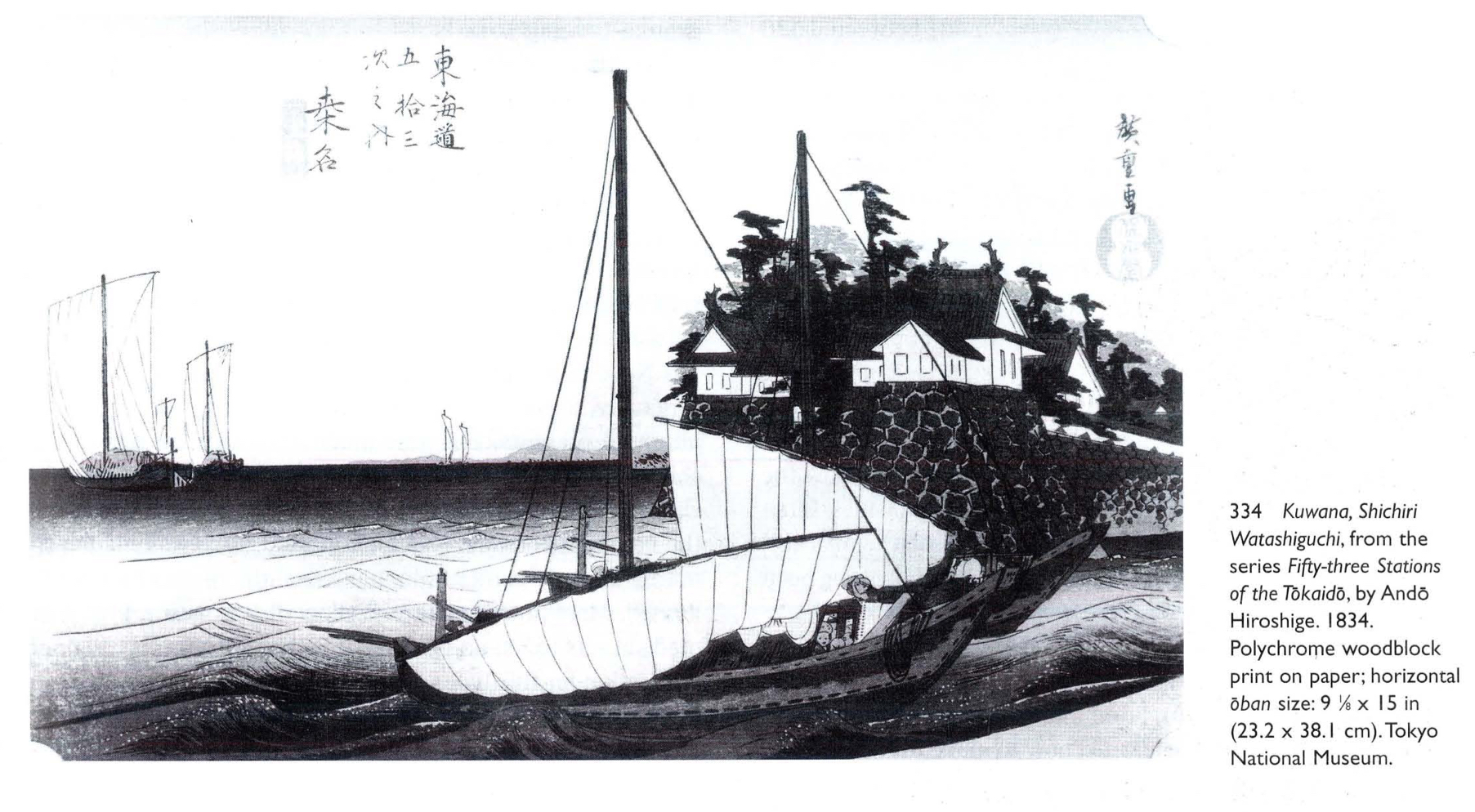
Kuwana, Shichiri Watashiguchi, 53 Stations of the Tokaido (334)
1834
Ando Hiroshige
This print depicts the scenic view of the Kuwana area, showcasing Hiroshige's skill in capturing the beauty of landscapes and the intricacies of daily life along the Tokaido road.
Ukiyo-e: The 53 Stations of the Tokaido is an iconic example of ukiyo-e, a genre of woodblock prints that depicts scenes of everyday life, landscapes, and famous locations.
Nishiki-e: The prints in the 53 Stations of the Tokaido series, including the Kuwana station, are nishiki-e as they use full-color printing, with multiple blocks for different colors.
Oban – Standard print size for ukiyo-e (about 15" x 10").
Polychrome woodblock print on paper.
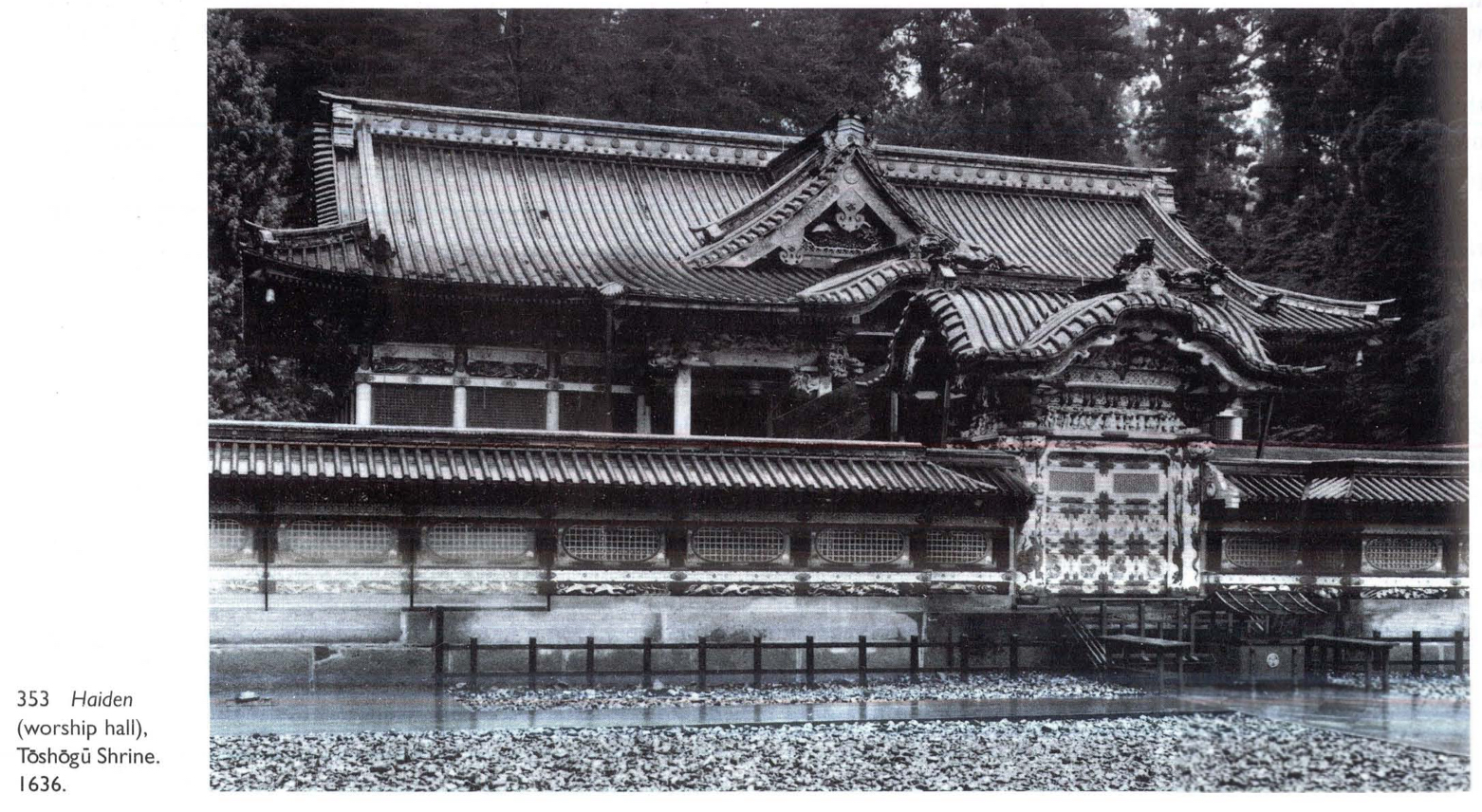
Haiden (worship hall) Toshogu Shrine (353)
1636
Toshogu Shrine features intricate carvings and a beautifully painted facade, serving as a place for worship and ceremonies dedicated to the Tokugawa shogunate.
The Haiden is the hall for prayers and rituals at Toshogu Shrine, dedicated to Tokugawa Ieyasu, the first shogun of the Tokugawa shogunate.
Style: A blend of traditional Shinto architecture with elaborate decorations characteristic of the Edo period.
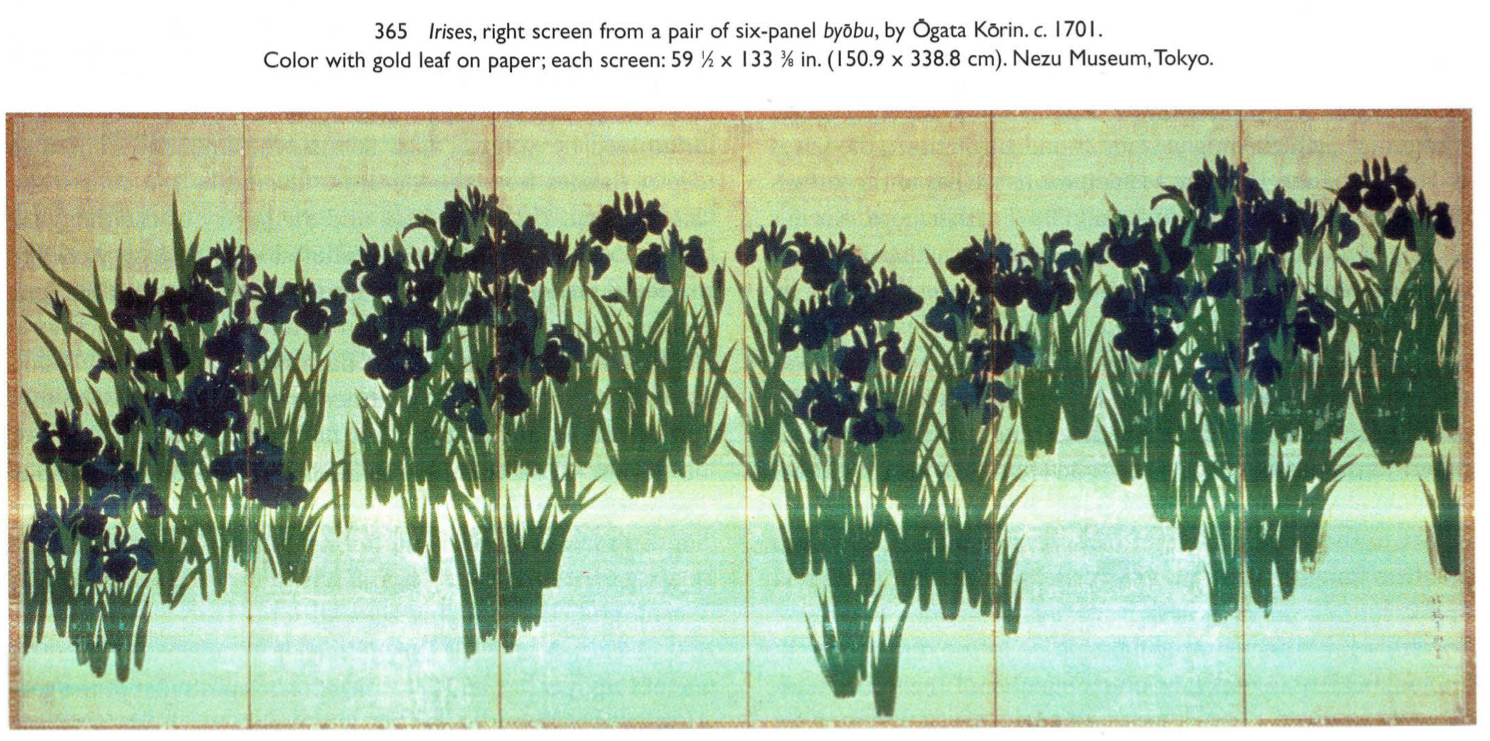
Irises (365)
1701
Ogata Korin (Rinpa school)
This screen painting showcases vividly colored irises, exemplifying Korin's innovative use of design and color, blending nature with artistic expression. It reflects the aesthetics of the Rinpa school.
Byobu, color with gold leaf on paper
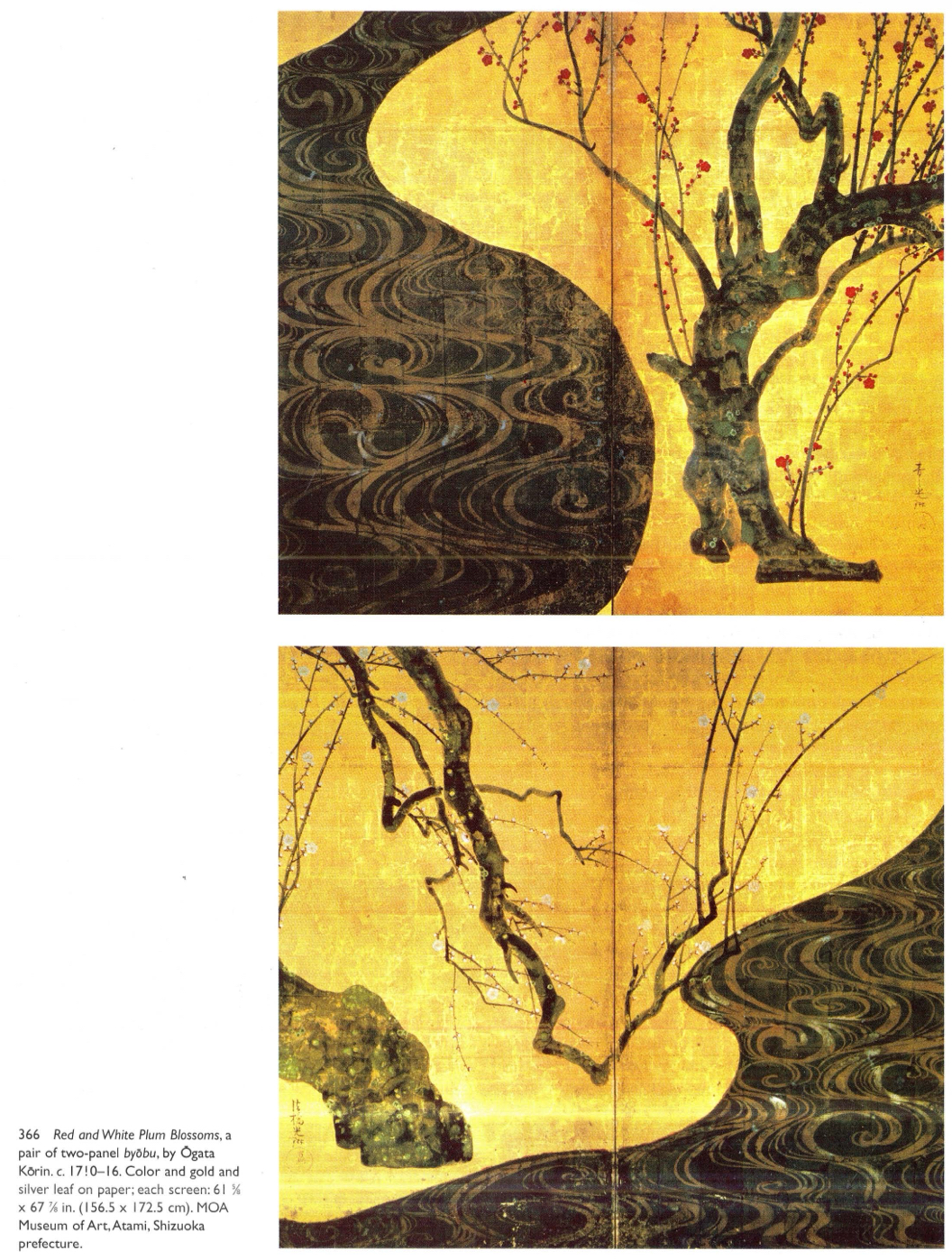
Red and White Plum Blossoms (366)
1710
Ogata Korin (Rinpa School)
This famous folding screen painting depicts vibrant plum blossoms in a harmonious interplay of red and white, showcasing Korin's mastery of color and form, while embodying the principles of the Rinpa school.
Rinpa was also associated with the philosophy of wabi-sabi, which celebrates the beauty of imperfection and transience
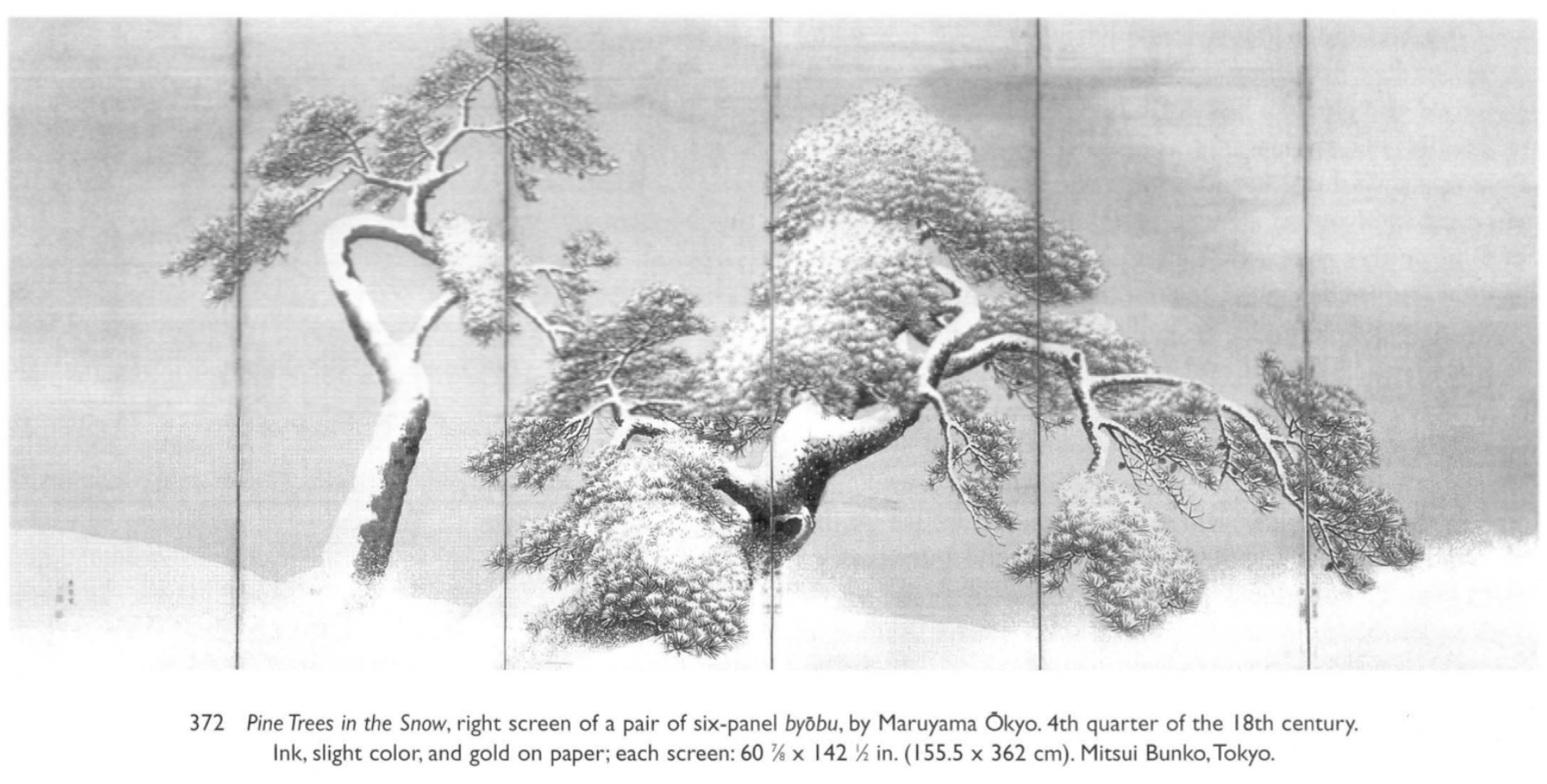
Pine Trees in the Snow (372)
Late 18th Century
Maruyama Okyo
Shijō School – Naturalistic style blending Western realism with Japanese themes, founded by Maruyama Okyo
While it uses touches of color, this work is grounded in the ink painting tradition, with subtle tones and empty space.
Showcases the influences of western perspective on japanese art
Ink, slight color, and gold on paper

Rooster, Hen, and Hydrangea (375)
1757
Ito Jakuchu
This work is a classic of kachōga, a genre with roots in Chinese painting, but fully embraced in Japan, especially by painters like Jakuchū.
A unique figure: trained in Zen Buddhism and the son of a Kyoto grocer, he merged spiritual contemplation with merchant-class taste for elaborate, eye-catching art.
Hanging scroll, color and ink on silk
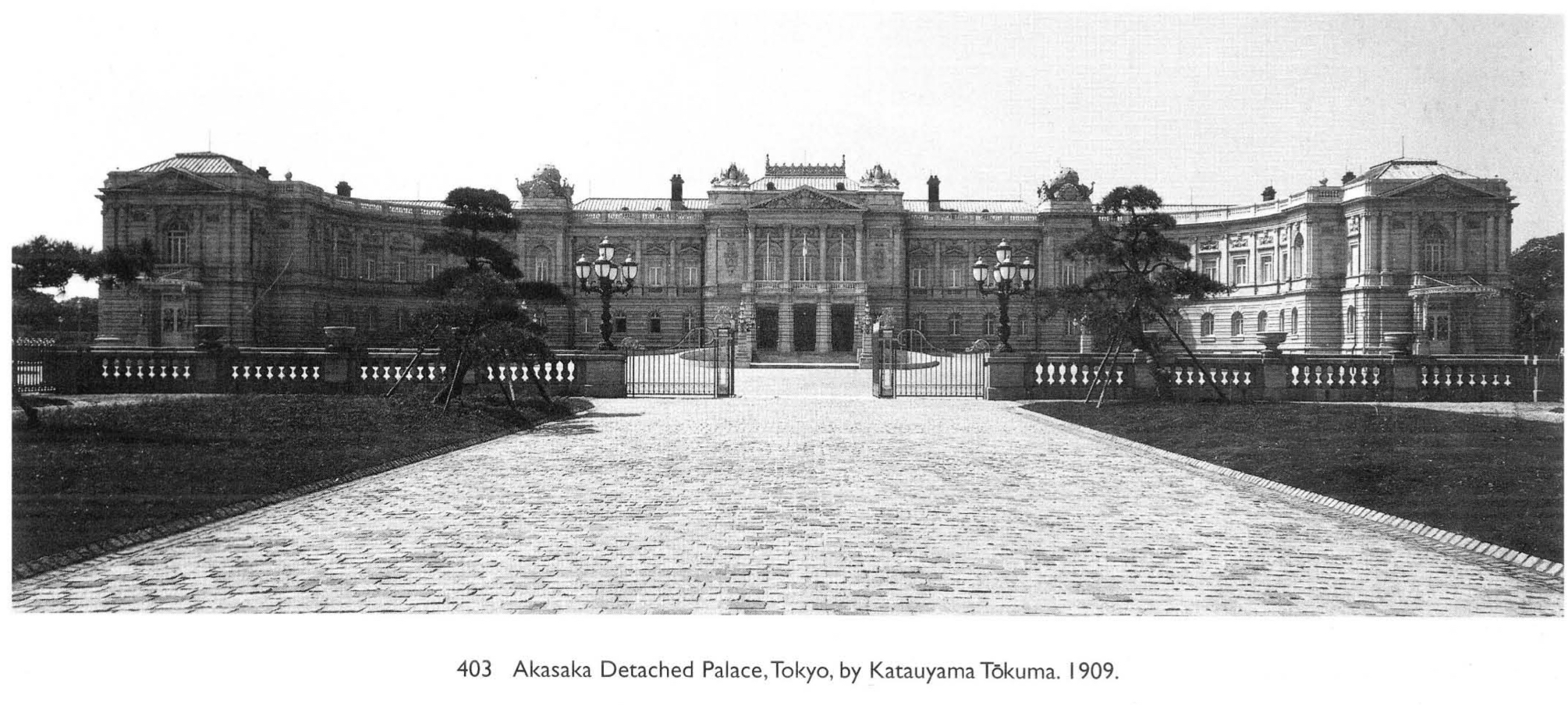
Asakasa Detached Palace (403)
1909
Katauyama Tokuma
Originally built as the Imperial Crown Prince’s residence, now used for state functions and visiting foreign dignitaries.
Tatsuno Style – Western-style architecture by Tatsuno Kingo, blending Meiji-era modernization with classical motifs.
the Western-inspired architectural style (Baroque/Renaissance revival) of the Akasaka Palace is directly related to the broader trend known as Tatsuno Style. It reflects the Japanese adoption of European aesthetics during the Meiji period to signal modernization and imperial prestige.
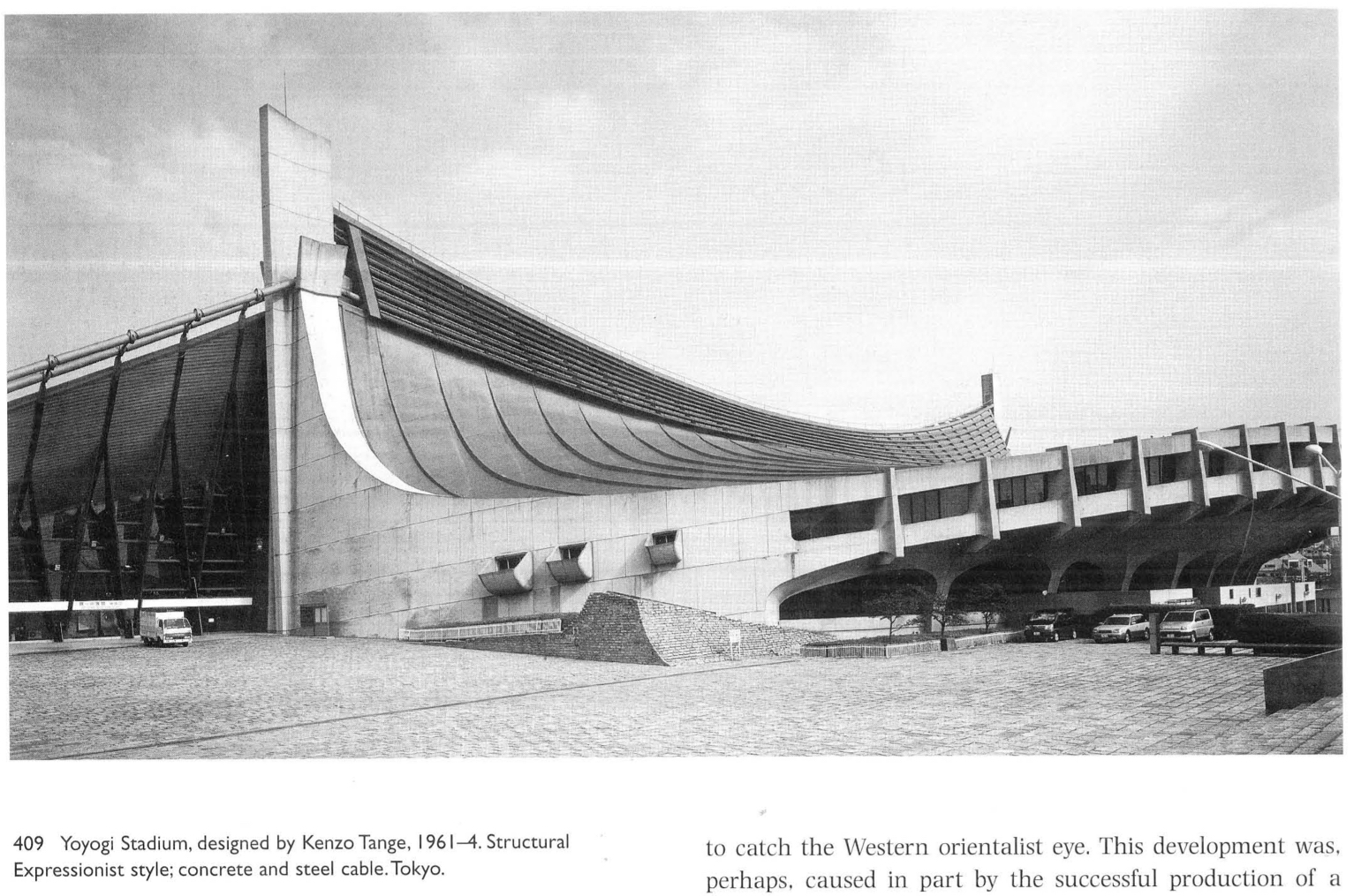
Yoyogi Stadium (409)
1961-64
Kenzo Tange
Tange represents postwar modernism that combines Japanese tradition with international modern architecture.
Yoyogi Stadium is a radical departure from Tatsuno Style.
Built for the 1964 Tokyo Olympics (used for swimming and diving events)
Expressionist style; concrete and steel cable
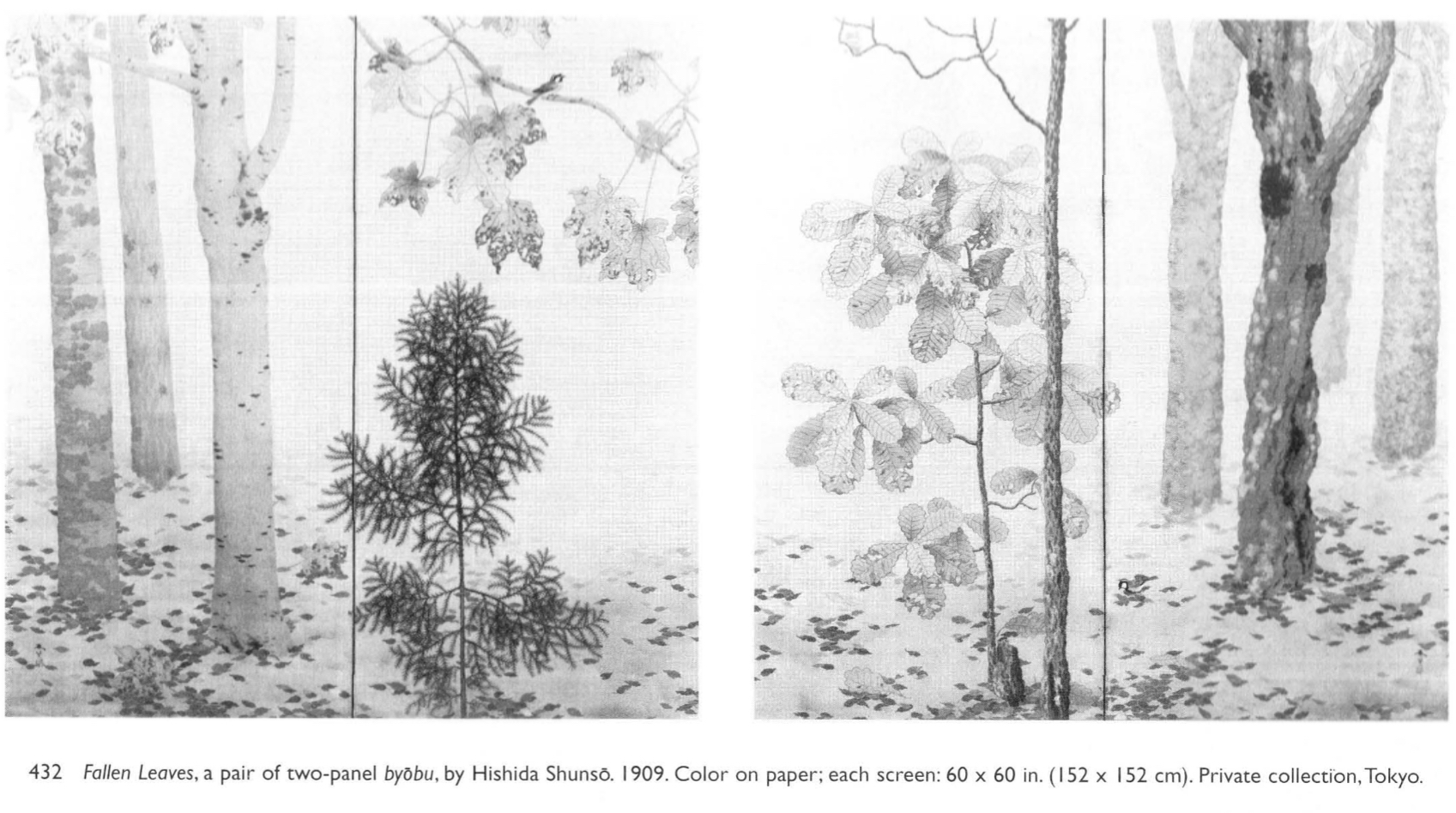
Fallen Leaves (432)
1909
Hishida Shunso
Mōrōtai – Shunsō pioneered this technique — soft, blurry brushwork with minimal outlining to suggest mood and depth rather than clear contours. Fallen Leaves is the textbook example of this method.
Nihonga – Traditional Japanese-style painting developed in contrast to yōga.
Byobu, color on paper
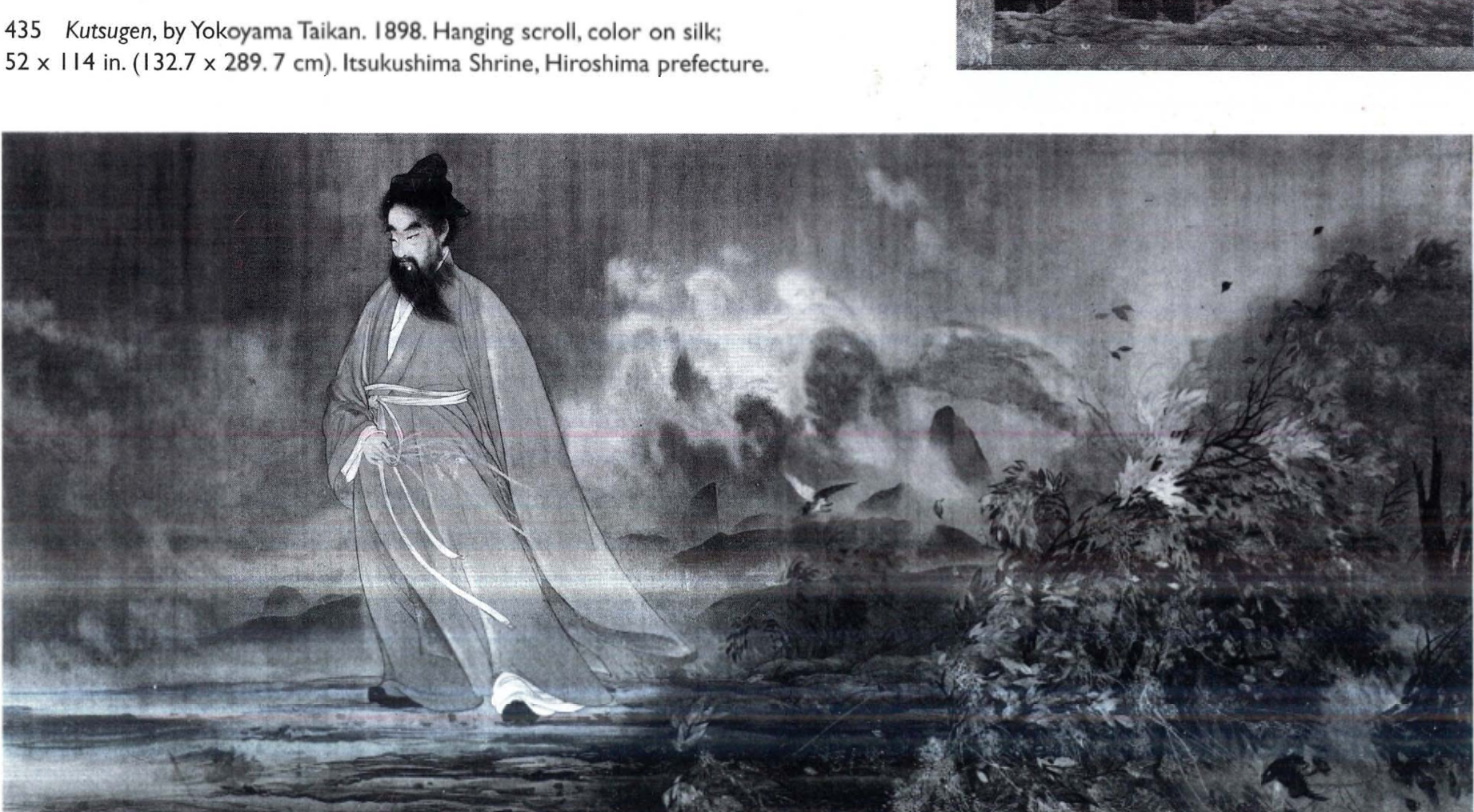
Kutsugen (435)
1898
Yokoyama Taikan
Nanga – “Southern painting,” literati-inspired art emphasizing poetry and brushwork.
Nihonga – Traditional Japanese-style painting developed in contrast to yōga.
Hanging scroll, color on silk
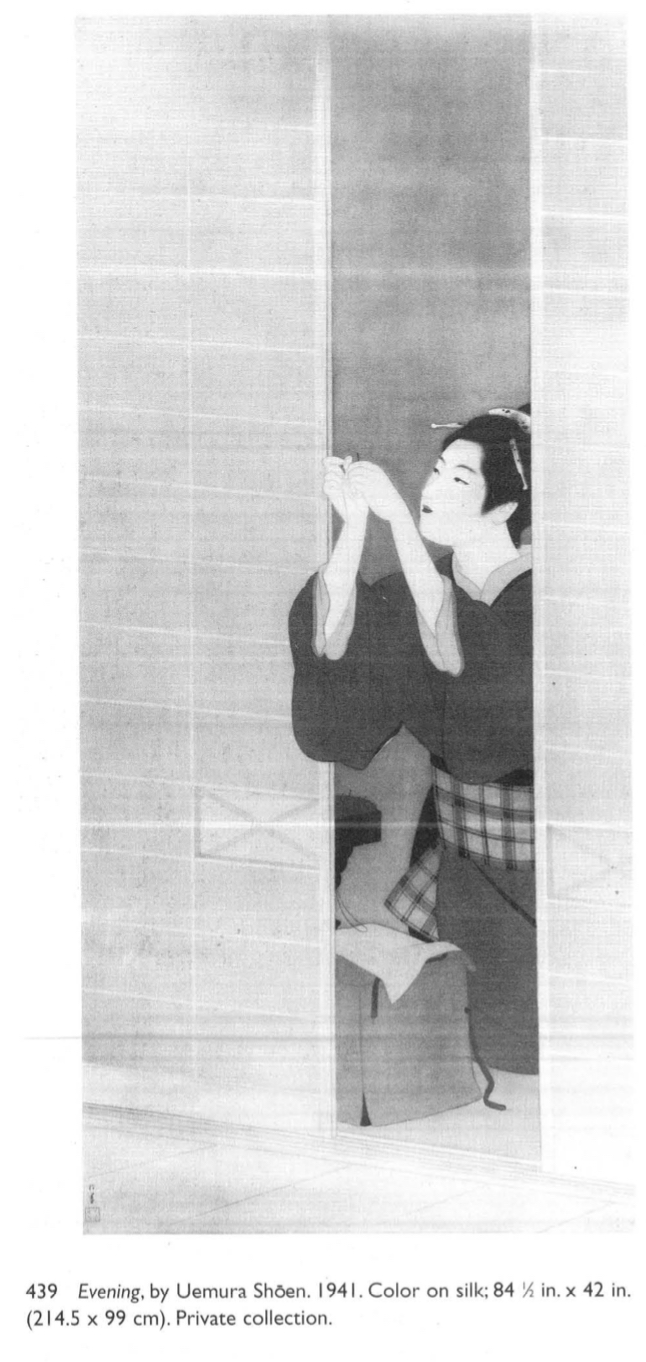
Evening (439)
1941
Uemura Shoen
Bijinga – “Pictures of beautiful women,” a genre in ukiyo-e focusing on fashion and grace.
Nihonga – Traditional Japanese-style painting developed in contrast to yōga.
Color on silk
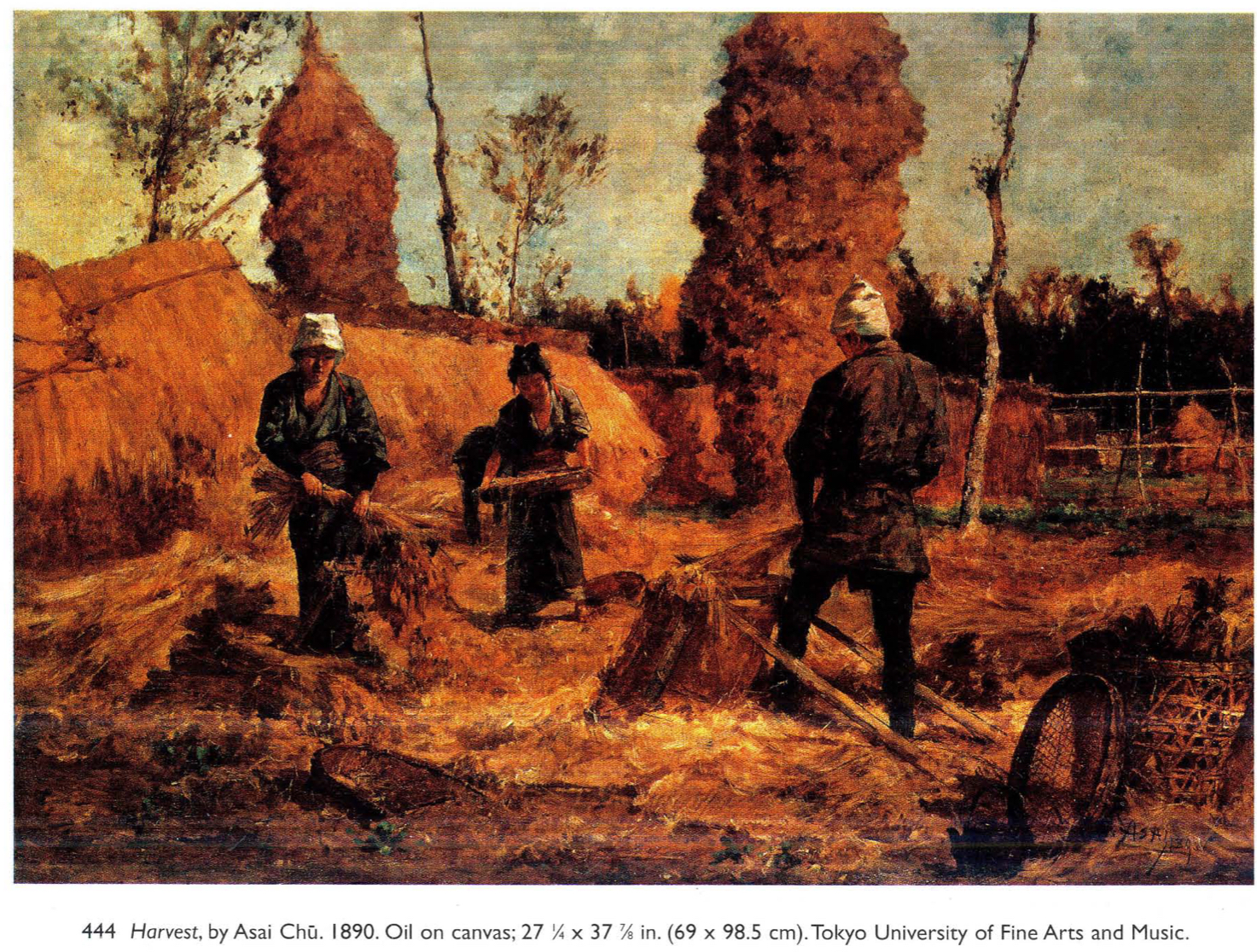
Harvest (444)
1890
Asai Chu
Yoga – Western-style painting introduced during the Meiji period.
Oil on canvas
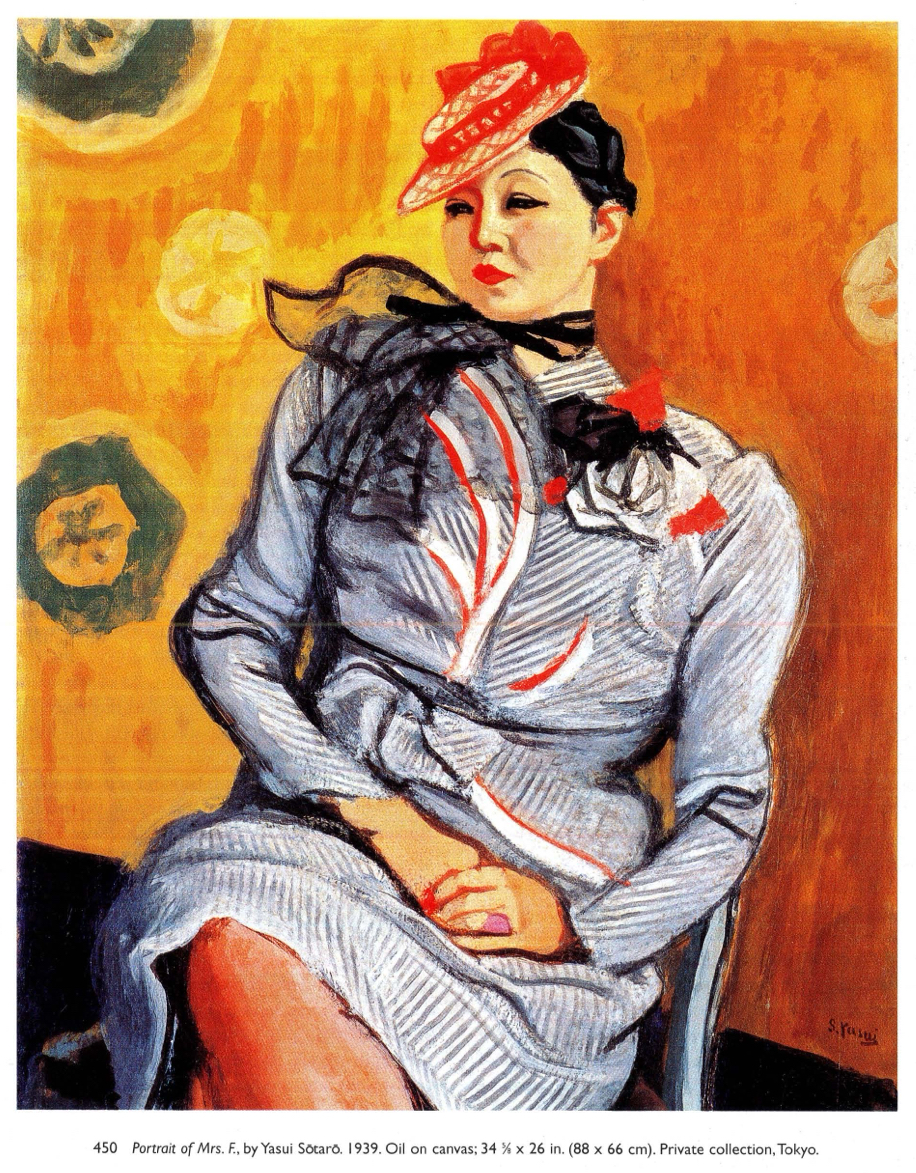
Portrait of Mrs. F (450)
1939
Yasui Sotaro
Bijinga – “Pictures of beautiful women,” a genre in ukiyo-e focusing on fashion and grace.
Yoga – Western-style painting introduced during the Meiji period.
Fauvism
Oil on canvas
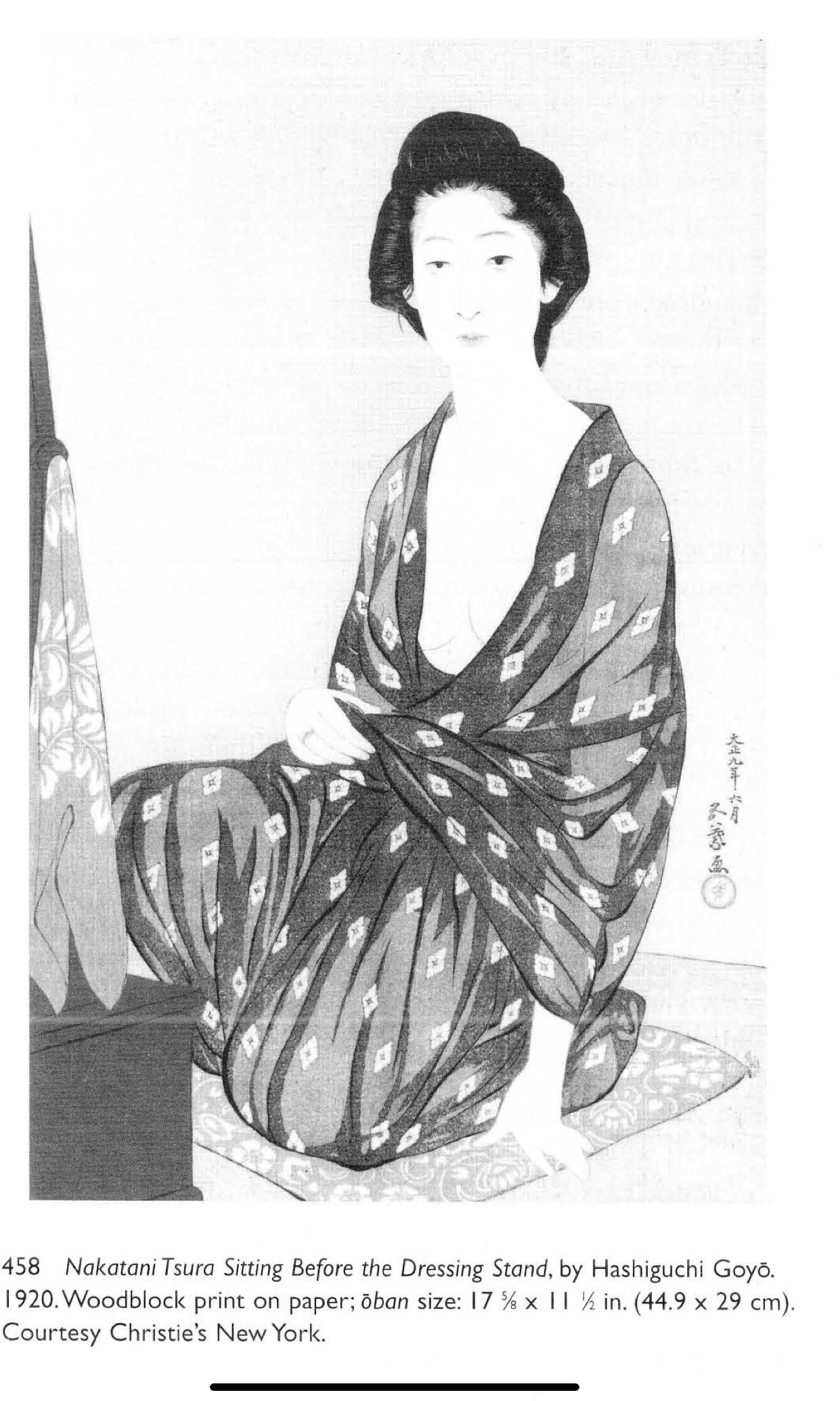
Nakatani Tsura Sitting Before the Dressing Stand (458)
1920
Hashiguchi Goyo
Nihonga – Traditional Japanese-style painting developed in contrast to yōga.
Bijinga – “Pictures of beautiful women,” a genre in ukiyo-e focusing on fashion and grace.
Woodblock print on paper
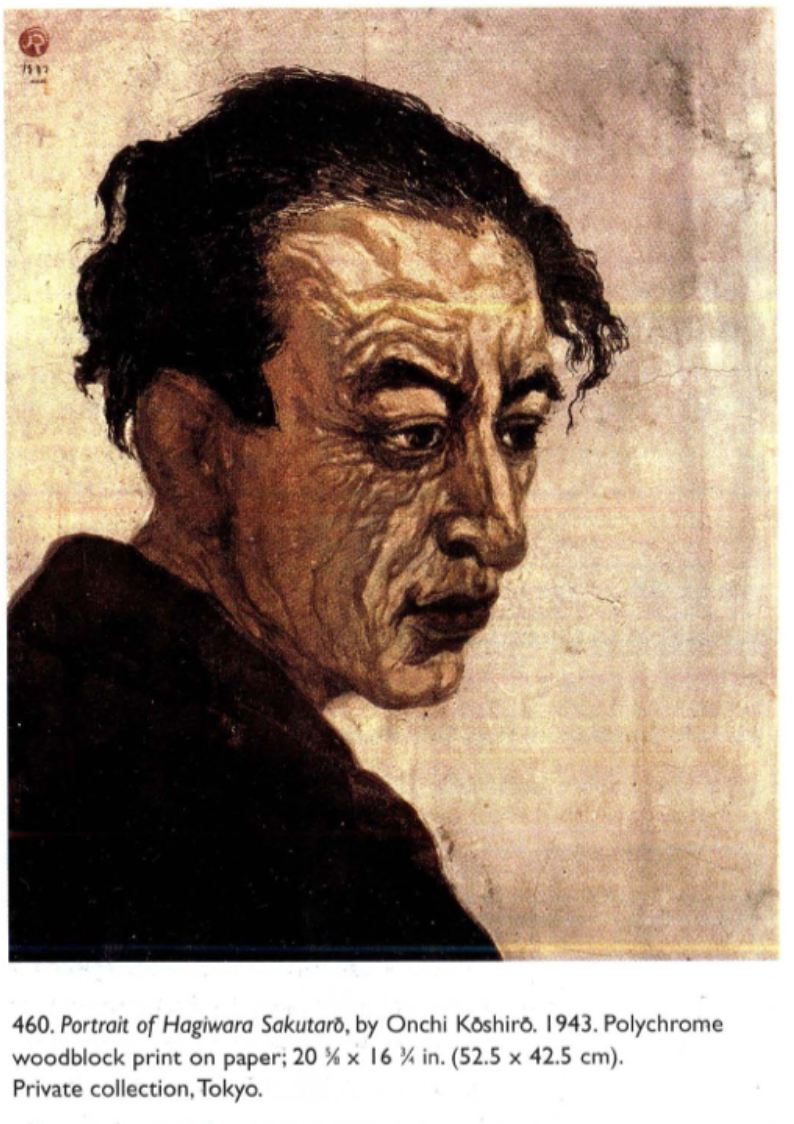
Portrait of Hagiwara Sakutaro
1943
Onchi Koshiro
Sōsaku Hanga – “Creative prints,” emphasizing the artist’s hand in all stages of printmaking, did all aspects by himself as opposed to Shin Hanga, which is more collaborative
Woodblock print on paper